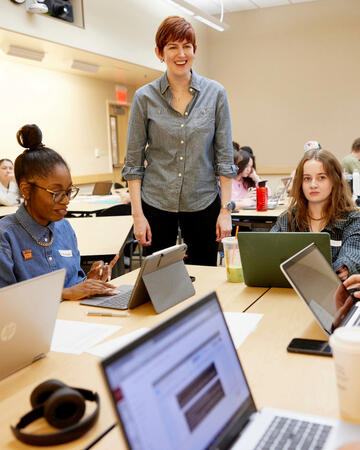Students were grimacing. It was a simulation, and the assignment was intense.
For this scenario, their instructor, Rebecca Rice, assistant professor of communication studies, created a hypothetical company accused of mishandling the safety and distribution of food.
Rice posted social media posts from the public bemoaning the faux corporation. The students had to work in teams to figure out responses. Media requests were coming in. Emails from the legal department popped up. One problem after another. Students had one hour to write back responses and conduct a press conference.

It was a hypothetical scenario, sure, but the situation still made the students sweat.
Scheherazade Pollins, an undergraduate communication studies major graduating this May, said the class scenario was similar to her experiences working as a social media manager.
“Being put in the middle of a crisis the moment you walk in is reminiscent of what the working world is like. There were times when I would leave work and everything was fine only to come in the next day and everything was falling apart and you have to fix things fast,” Pollins said. “This simulation put us in that same frame of mind. It was stressful, but it allowed us to show what we had learned up to that point in the course.”

Rice talked about how the communication studies course, called The Corporate Scandal, prepares students to understand the ethics behind corporate responsibility and how to navigate emergency situations from a crisis communication perspective.
How do you define a corporate scandal?
A corporate scandal is a crisis that threatens the reputation of a company in the eyes of its stakeholders — whether that is employees, customers, or regulators.
Why did you include a crisis communication simulation in your course?
I included a scandal-stimulation because of my research on emergency management.
Emergency managers often have tabletop emergency exercises, where they practice for hypothetical emergencies. It’s a really good way to identify gaps in response capabilities. It’s also important to feel what an emergency actually feels like — it can be so hard to think clearly and make clear communication decisions. I want students to feel that adrenaline now so that if they ever encounter them in real life, they are used to those stressed feelings and can still function.
What motivated you to create this class?
I wanted to create a class about a common social problem — that companies misbehave, creating problems for themselves, employees, and consumers. My students in organizational communication class were fascinated by the Elizabeth Holmes/Theranos scandal, so we talked about that a lot. So, I thought let’s have a whole class on it.

Why do you think this class is important for students to take?
Students are likely to face emergencies, crises, and scandals at work — even if they don’t go into crisis communication. It’s important to understand how to communicate during these stressful moments and to practice. It encourages them to think about how clear and ethical communication can help their future workplaces to succeed.
What themes do you address in this class?
We talk about what causes scandals and how to communicate during them. Then, during the second half of the semester, we talk about ethics and corporate social responsibility. Basically, we are asking, "Why do companies continue to get mired in scandals?” and “How can communication help them to design ethical companies that avoid scandals?”
What skills are students gaining through this class?
Students gain skills in crisis message design, teamwork, and staying calm under pressure.
Quick Facts About The Corporate Scandal Course
- The current course number is COM 330: Selected Topics in Communication Studies. It will change to another course title COM 313: Corporate Scandal in spring 2025.
- The course is open to all undergraduate majors and it is an elective.
- It’s available only in person.



